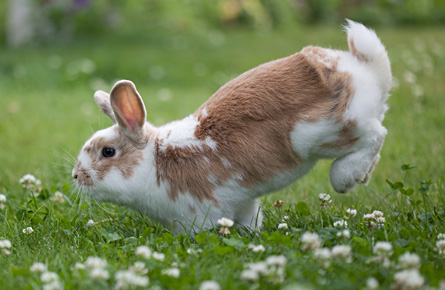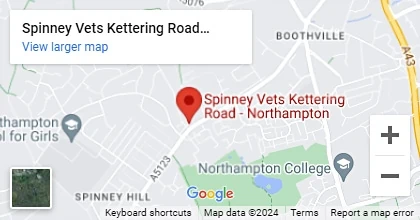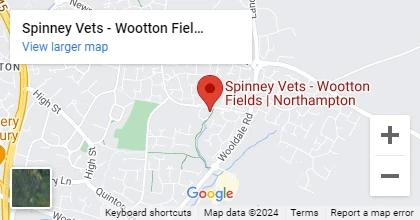In male dogs, both testes are removed; this is known as ‘castration’. In female dogs, either the uterus is removed or both the uterus and the ovaries; this is known as ‘spaying’.
Spaying a female dog eliminates the ability to reproduce, and your dog will no longer come into season. Females can be neutered from six months of age; for most breeds, we suggest spaying females before they have had a season, known as pre-season. If your dog is older than six months or has already started having seasons, we would need to wait three months after a season to ensure we are operating at the best possible time.
Here at Spinney Vets, we can also perform a female dog ‘spaying’ procedure via keyhole surgery; your pet would have three small incisions, and females often recover faster from this surgery.
 Neutering or spaying your dog:
Neutering or spaying your dog:
-
Prevents unwanted pregnancies and womb infections
-
Can help prevent tumours and breast cancer
-
Can also help prevent testicular cancer and prostate disease
-
Assists in preventing roaming and aggressive behaviour
-
It’s normal to neuter! 71% of owned dogs in the UK are neutered*
*PSDA Paws report 2020
At what age are dogs neutered or spayed?
Dog neutering is usually carried out at around six months of age for males and pre-season for female dogs, reducing the likelihood of females developing mammary cancer. We would also consider your dog’s breed, size, overall behaviour, and other risk factors to provide the most suitable recommendation for your dog based on the latest evidence.
Male dogs older than six months can be neutered at any stage; however, we would still consider the dog’s breed, size, overall behaviour, and other risk factors upon discussion of the dog neutering procedure.
If your dog is not spayed before her first season, we would wait three months after the season.
Should I let my dog have one litter before spaying her?
This happens to be a common question, and there are no known health benefits to letting your dog have a litter; this is also the same for cats and rabbits.
General anaesthesia for dog neutering
Your pet requires a general anaesthetic for neutering; here at Spinney Vets, we have measures in place to ensure their safety during the procedure. A dedicated Registered Veterinary Nurse (RVN) will monitor your pet throughout their surgery and recovery. All anaesthesia comes with some form of risk; however, these are very low, especially neutering, as pets are often young, fit, and healthy when having this procedure.
Risk levels of anaesthesia increase with a pet’s age, certain breeds, and if your pet has any underlying health conditions. We can perform a pre-anaesthetic blood test before your pet’s surgery, to detect any underlying illnesses; this can be discussed when booking in for the procedure and on the day of their surgery. Your pet will receive a premedication to relax them and will also receive two types of pain relief. Rest assured the Spinney team will be with your pet every step of the way.
Your pet will stay the day with us
On the day of the procedure, please bring your dog on a secure harness or lead; during the admission appointment, we will discuss the procedure and go through the consent form. Please note we must gain a signature from the registered owner (over 18) or authorised agent on the consent form. Your dog will be admitted as a ‘day patient’, and they will be discharged later that day once our team is happy with how your pet has recovered.
During your pet’s discharge appointment, the team will go through everything you need to know about caring for your pet after their surgery and their pain relief medication. We are always at the end of the telephone for you and your pet, so please contact us if you have any further questions once you have your pet settled back at home on 01604 648221.
Pet Health for Life Plan Offer
Spinney Vets Pet Health Plan members can claim a 10% discount on neutering procedures. Our health club offers preventative health, and you could be saving each year on what you spend on your pet treatment.
Dog Neutering Frequently Asked Questions
What is Puppy Spaying?
Puppy spaying is a surgical procedure in which a female dog’s ovaries and, in some cases, her uterus are removed to prevent reproduction. The male equivalent is castration, where both testicles are removed.
At What Age Can My Puppy Be Neutered?
We typically recommend neutering puppies at around six months of age. Female dogs can be spayed before their first season or after their first season. Male dogs can also be neutered from six months onwards.
How Long is the Recovery After Spaying?
After spaying, female dogs generally need at least two weeks to recover fully. However, this may vary depending on the breed and individual dog. Our team at Spinney Vets in Northampton will provide comprehensive aftercare guidance, pain relief, and post-surgery care to support a smooth recovery.
What Are the Benefits of Neutering My Dog?
Neutering provides several health and behavioural benefits, including:
- Preventing unwanted pregnancies
- Reducing the risk of certain cancers (testicular in males, mammary in females)
- Preventing prostatic diseases in males
- Reducing aggression and roaming tendencies
- Lowering the risk of serious uterine infections in females
- Reducing scent marking and other unwanted behaviours in male dogs
Does My Dog Need to Have a Litter Before Being Spayed?
No, there is no medical benefit to allowing your dog to have a litter before spaying. Early spaying helps prevent reproductive complications and reduces the number of unwanted puppies.
What if My Dog is Older Than Six Months or Has Already Had a Season?
If your female dog has already had a season, we generally recommend waiting around three months after her last season before spaying. This helps minimise surgical risks and ensures the best possible outcome. Our vets will assess your dog and determine the best timing for the procedure.
For further advice or to book a neutering appointment, contact Spinney Vets in Northampton today.
Further reading:
Neutering your cat | Neutering your rabbit









